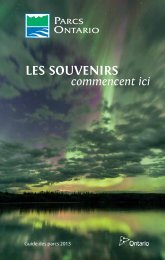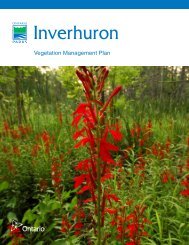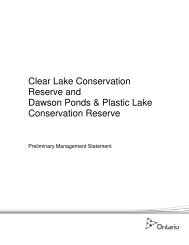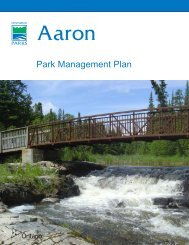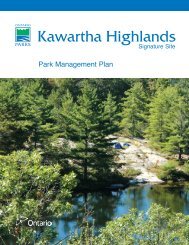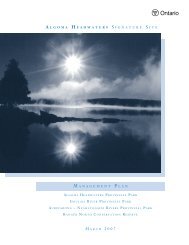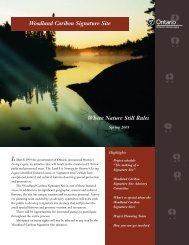Vegetation Plan - Ontario Parks
Vegetation Plan - Ontario Parks
Vegetation Plan - Ontario Parks
You also want an ePaper? Increase the reach of your titles
YUMPU automatically turns print PDFs into web optimized ePapers that Google loves.
1.3 Historic Influence on <strong>Vegetation</strong> Communities<br />
Most of the vegetation in the park is second-growth forest and in the early stages of succession because of<br />
logging and land clearing prior to park establishment (OMNR 2000). The bulk of the park is coniferous forest of<br />
which Eastern White Cedar (Thuja occidentalis) is the dominant species (TSH 2003). More mature forests are<br />
present along the banks of the Little Sauble River, which are the result of being protected as a timber preserve<br />
from a sawmill that historically operated near the mouth of the river (TSH 2003). Agricultural activities in the<br />
1800s have left remnants of settlers’ attempts to cultivate the land, such as overgrown fields near the park<br />
entrance (NHIC 2005). Other examples include remnants of garden escapees such as Lilacs (Syringa vulgaris)<br />
and irises (Iris sp.) brought by settlers, homesteaders and cottagers (Helling et al. 1970, Fitzgerald 2000, 2001).<br />
From the 1950s to the 1970s some park staff lived in the park and planted non-native garden species in the<br />
areas around their residence and park buildings, as well as trees to stabilize the dunes (N. Toth, Personal<br />
Communication 2006). There were also major fires in the 1880s within the park boundaries, which caused<br />
damage to vegetation and altered the landscape (Fitzgerald 2001). A fire in 1887 is cited as having destroyed<br />
most of the former town of Inverhuron's buildings and vegetation, resulting in the mobilization of exposed sand<br />
(Fitzgerald 2001).<br />
In an effort to stabilize sand dunes, large portions of the dunes have been planted with non-native species such<br />
as Scots Pine (Pinus sylvestris) and Austrian Pine (Pinus nigra) (TSH 2003).<br />
In the vicinity of the new campground development, remnants of the old campground facilities can still be<br />
detected in the form of transitional vegetation (young cedars and Balsam Fir (Abies balsamea)) growing along<br />
old roads and trails (TSH 2003).<br />
4



